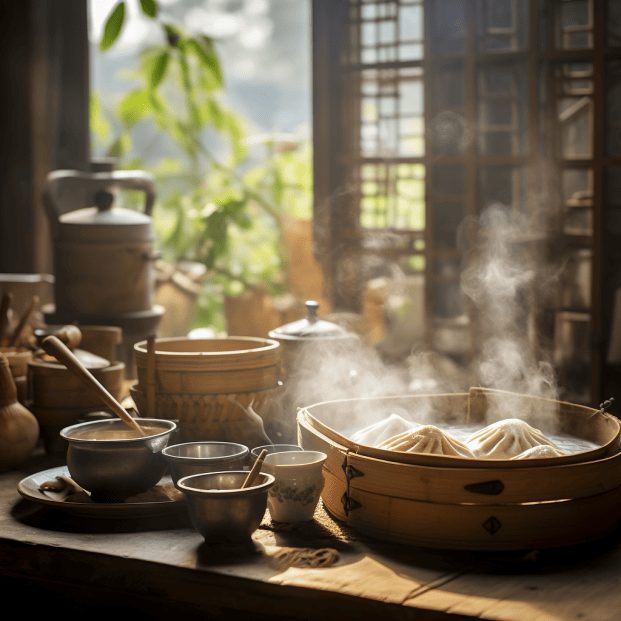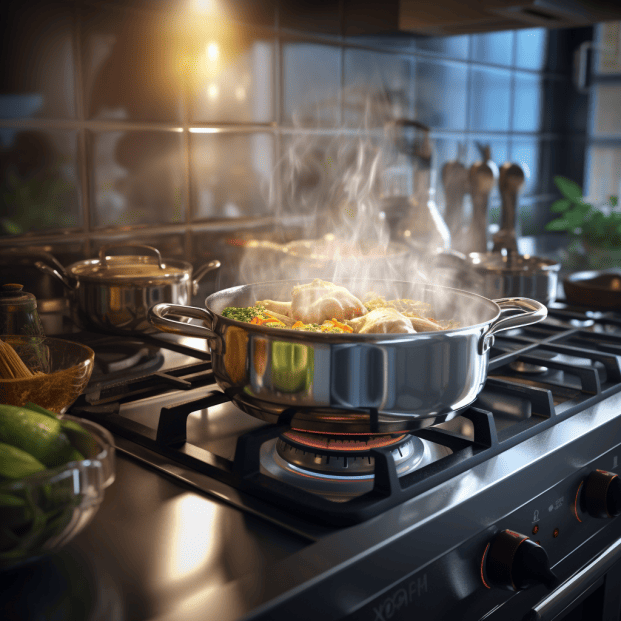Can you use bottled water to steam foods and reap all the benefits?
As someone who loves cooking healthy but hates waiting for my ancient kettle, I’ve tested out using good ol’ bottled water to quickly steam veggies, dumplings, fish and more.
While it may seem like an easy shortcut, I discovered there are a few things to know before tossing a bowl on top of that Evian.
From funny mishaps with exploding bottles to soggy, under-steamed results, my trials and errors taught me the right way to steam with bottled water.
In this guide, I’ll share a hilarious story of a bottled water steaming fail in my tiny apartment kitchen.
You’ll learn quick tips for steaming success using just bottled water, bowls and a microwave or stovetop.
I’ll explain the key factor that makes or breaks the results.
By the end, you’ll know how to harness the convenience of bottled water to perfectly steam foods fast any night of the week.
No more waiting around for slow kettles and pots just to enjoy healthy steamed meals in minutes!
KEY TAKEAWAY
Can you steam with bottled water in cooking?
Yes, you can use bottled water for steaming, but it’s essential to consider the type of water and your steamer’s requirements for optimal results.
The Impact of Tap Water on Your Cooking
The type of water used in cooking can significantly impact flavors, nutrition and more. Here’s how:
- Tap water contains minerals affecting taste. Chlorine can leave unpleasant flavors. Limescale deposits on pots.
- Hard tap water prevents food from cooking properly. Beans and lentils fail to soften. Rice and pasta turn gummy.
- Chemicals like chlorine, fluoride and chloramine in tap water destroy delicate flavors and vitamins in food (1).
- Magnesium and calcium in hard water interact with ingredients, weakening gluten structures in bread. Dense loaves result.
- Pesticides, heavy metals and bacteria may lurk in some tap water sources. Consuming contaminated cooking water poses health risks.
- Purified bottled waters provide neutral flavors, so ingredients shine. They lack off-tastes and chlorine.
- Soft bottled waters don’t hinder cooking chemistry like hard tap waters. Foods cook up tender.
- Steam from unfiltered tap water deposits minerals on food. This dulls appearance of vegetables.
When cooking delicate foods, pure bottled waters help them truly express flavors and textures.
If you want more information regarding steaming and ingredients, check out for more information about low sodium Chinese food products.
Using Bottled Water for Steam Cooking

Thanks to its purity, bottled water creates perfect steam for enhancing food flavors and textures. Follow these tips:
- Use steamers with vented, stacking baskets. Condensation needs to escape, not drip down.
- Choose wide, shallow pans that enable food contact with rising steam. Narrow pots inhibit circulation.
- Fill bottom of steamer with only 2-3 inches of water. Avoid submerging food directly.
- Select still spring water for best results. The bubbling action of sparkling water causes erupting.
- Monitor levels and top off with more bottled water as needed. Don’t allow water to evaporate fully.
- Maintain a rolling boil for fastest steam production. Keep the heat high.
- Resist adding seasonings to the water, as condensation will make food salty. Season foods directly instead.
- Empty water after use instead of saving. Bottled water lacks preservatives found in tap.
Steaming with pure bottled water allows ingredients’ natural flavors to shine through. The results are noticeably brighter and fresher. Give it a try!
Choosing Water for Steaming: Tips and Considerations

Selecting the right water (2) is key for flavorful steaming. Here are tips for deciding:
- Consider your water source. Well water often contains more minerals than municipal sources.
- Test your tap water for hardness. Hard water has high mineral content that can hinder cooking.
- Taste your tap water before steaming food in it. Strong chlorine or metallic tastes will transfer.
- Filtered water removes off-tastes but leaves beneficial minerals. It improves but doesn’t fully purify tap water.
- Distilled and purified bottled waters provide neutral, pure taste. They allow ingredients’ flavors to shine.
- Spring water contains some minerals that enhance its flavor for drinking but are fine for steaming.
- Opt for still bottled water. Carbonation can cause boiling eruptions when steaming.
- Always use clean, safe drinking water. Don’t use unsafe well water of questionable quality.
Considering water taste, purity, and mineral content helps select the best option for flavorful steamed dishes.
Distilled vs. Bottled Water for Cooking
Distilled and bottled waters are both good options for pure, mineral-free steaming.
However, they differ in their creation processes and qualities:
Distilled water is created by boiling water and condensing the steam to remove all impurities.
The distillation process removes nearly 100% of contaminants and minerals.
This gives distilled water a flat, bland taste but the highest purity level.
It also tends to be cheaper at around $1 per gallon since a home distiller can be used.
However, distilled water requires bulkier packaging or an appliance.
Bottled water undergoes purification methods like reverse osmosis and ozonation to clean it.
While it does not undergo the full distillation process, bottled water still has very few traces of minerals left over.
It has a very light mineral taste depending on the source water.
Bottled water is subjected to FDA regulations with quality reporting requirements.
It is also more portable and convenient as single-use plastic bottles.
However, bottled water is significantly more expensive than distilled water.
Both distilled and bottled water create excellent steam quality for cooking purposes by removing minerals that could leave tastes or deposits.
For easier use andhandling, bottled water may be preferable despite the higher costs.
However, distilled water provides the highest purity level at a much lower price point if bulk packaging or a home distiller is used.
Ultimately, either choice allows food flavors to shine through clearly in steamed dishes.
Safe Water Choices for Cooking
It’s crucial to select safe, contaminant-free water for cooking.
Here are smart options:
Municipal tap water from a public treatment facility offers reliable safety for most people.
While not as pure-tasting as bottled or distilled, public tap water must adhere to strict testing and purification guidelines from the EPA.
Well water can contain contaminants like pesticides, heavy metals, and bacteria if not properly tested and treated.
Have well systems periodically inspected and opt for in-home filtering and purification systems as needed.
Don’t cook with untreated well water.
Bottled purified drinking water, whether distilled, spring, or filtered, provides a contaminant-free option.
Look for FDA-regulated bottled waters showing proper processing for safety.
Avoid ones that just say “well water”.
Boiling water vigorously for 1-3 minutes eliminates most bacteria and organisms if no other purification method is available.
This is recommended for untreated non-potable water in emergency situations or camping.
It does not remove chemical contaminants.
No matter which type you choose, always inspect water before cooking for any odd appearance, smell or taste which could indicate contamination issues.
When in doubt, stick to regulated treated municipal tap water or purchased purified waters to ensure safety.
Potential Health Concerns of Distilled Water in Cooking
While pure, using only distilled water long-term can pose some health risks:
Lacking minerals, it pulls minerals from the body to attain equilibrium through osmosis.
This can lead to electrolyte imbalances over time.
Distillation removes helpful minerals like calcium and magnesium needed for bone health, nervous system function, hydration and more.
The flat, acidic taste often prompts drinking less water, leading to deficiencies.
Since it is hypotonic, distilled water can disrupt cell function in the digestive tract.
Without minerals that normally prevent metal leaching, distilled water can absorb hazardous substances from pipes and containers.
For occasional steaming uses, distilled water poses little risks.
But for all cooking and drinking needs, experts recommend re-mineralizing distilled water or alternating it with mineral water.
Or simply stick to minimally processed bottled waters.
Effect of Unfiltered Tap Water on Food
When cooking directly with unfiltered tap water without prior boiling or purification, impurities may unintentionally enter food and dishes.
Yet a common misconception persists that typical municipal supply poses little risk.
In truth, tap sources frequently contain traces of metals, chemicals and microorganisms that cooking doesn’t destroy.
Over long-term consumption, contaminants could theoretically affect health, though minor.
More practically, certain compounds may alter food properties.
Dissolved calcium decreases acidity in tomato-based meals.
Chlorine lends a chemical aftertaste.
Worst, pathogenic bacteria from poorly treated water presents concern if the ill gets unlucky.
FAQs: Cooking with Different Water Sources
How do mineral waters impact cooking?
While bearing minerals provides no innate harm, high levels can leave sediments in appliances like steam mops. Moderate amounts enliven flavors for some.
What if my faucet looks cloudy? Aesthetics poorly indicate potability. Unless notices warn, continue regular use whilst monitoring for symptoms. Cloudiness likely involves non-toxic calcium.
Should I buy drinkable or bathroom water jugs?
Potable types marked drinking water or food grade protect utensils and health. Check seals, storage, and truck origins before hauling major volumes home.
How often do boil water events occur?
Fortunately infrequently, these result from seasonal pipe issues, maintenance, or natural disasters as utilities strive to prevent contaminated public supplies and notify residents promptly through all channels until remedied.
While imperfect, modern municipal systems deliver affordable, usually clean liquid supporting staple conveniences.
Minor preventative steps like filtering or boiling further ensure a pleasant aroma and peace of mind with every drop.
Conclusion
Now you can skip slow steamer pots and kettles, and rely on the convenience of bottled water for fast steaming magic.
With the right microwave or stovetop techniques, bottled water transforms into a quick steaming solution.
Remember the key pointers like venting lids, using wide containers, and keeping water levels low.
I hope you enjoyed my funny story of steaming mishaps while I figured this out the hard way! Let me know if you have any other quick steaming tips to share.
And please pass this guide along to any other busy folks who love steaming veggies and want to cut the wait.
Here’s to quick, healthy meals with the shortcut secret of steaming with bottled water.
If you are curious whether you can use tap water in cooking or not, check out the article for more information.
References
- https://www.cdc.gov/healthywater/drinking/public/water_disinfection.html#:~:text=Chlorine%20and%20chloramine%20are%20the,your%20utility’s%20consumer%20confidence%20report%20.
- https://www.medicalnewstoday.com/articles/327395
Related Articles
- https://bowlakechinese.com/low-sodium-chinese-food-products/
- https://bowlakechinese.com/steaming/
- https://bowlakechinese.com/can-you-use-tap-water-to-steam-food/
Was this helpful?

I am a skilled chef assistant with a passion for Asian cuisine, I have honed my craft through formal training at At-Sunrice GlobalChef Academy and years of experience in the culinary industry. I have extensive knowledge of cooking techniques and herbs and spices, with a particular focus on traditional Chinese dishes. I’m also an author of the book “Delicious Keto Low Carb Chinese Food for Busy Moms and Fitness Enthusiasts” which is sold on Amazon. On my blog, bowlakechinese.com, I share my expertise in Asian cuisine and provide tips and recipes for those interested in low carb Chinese cuisine.

